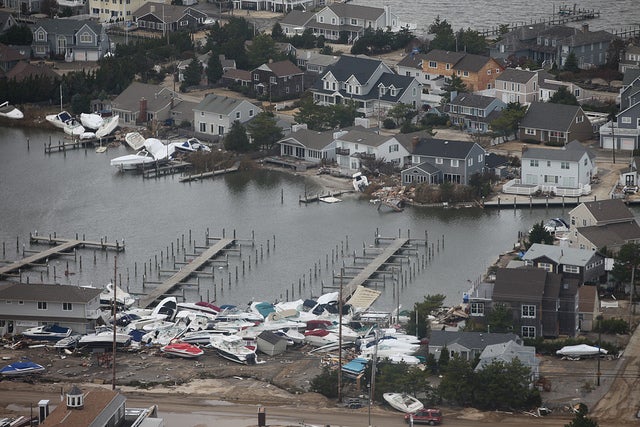With the autumn boat buying season approaching, boating group warns: buyer beware

Damage inflicted by Superstorm Sandy at the Harbour Yacht Club & Marina in Brick. (Photo: U.S. Fish and Wildlife Service Northeast Region via Flickr)
Autumn is traditionally when boat buyers can snatch a bargain on a used boat, capitalizing on deals offered by owners seeking to avoid winter storage fees.
But with tens of thousands of boats impacted when Superstorm Sandy struck last October, some of these vessels may be on the market during the prime buying season, a national boat owners association warns.
Boat Owners Association of The United States (BoatUS) estimates that 65,000 recreational boats throughout the region were either lost or damaged during the superstorm, with 25,000 in New Jersey at a cost of $242 million here alone.
“Now, nearly a year later, some of those boats are being sold on the used boat market, either in ‘as is’ condition, or after repairs have been made. That’s not necessarily a bad thing if the seller is truthful about any past damage. However, the problem exists when sellers fail to fess up to a boat’s true condition,” a release from BoatUS states.
The boat owners association offers the following post-Sandy boat buying tips:
Trace the history: When a car is totaled, the title is “branded” as salvaged or rebuilt and buyers know up front that there was major damage at some point in the car’s history. But few states brand salvaged boats and some states don’t even require titles for boats. “Anyone wishing to obscure a boat’s history need only cross state lines to avoid detection, which can be a tip-off,” says BoatUS Consumer Affairs Director Charles Fort. Also look for recent gaps in the boat’s ownership, which may mean that it was at an auction or in a repair yard for a long time.
Ask the seller: In some states, a seller is not required to disclose if a boat was badly damaged unless you ask them. If the seller hems and haws, keep looking.
Look for evidence of storm damage: A boat you are looking at has an increased likelihood of having been badly damaged in a storm if you see two or three of the following:
Recent hull repair: Especially on older boats, matching gel-coat is very difficult. Mismatched colors around a repaired area are often a dead give away, and may signal nothing more than filler under the gel-coat, rather than a proper fiberglass repair.
New repairs or sealant at the hull-to-deck joint: Boats that bang against a dock or other boats during a storm often suffer damage here.
Evidence of sinking: Check for consistent corrosion on interior hardware, such as rust on all hinges and drawer pulls. You might be able to spot an interior waterline inside a locker or in an area hidden behind an internal structure.
Extensive corrosion in the electrical system: Corrosion on electrical items, such as lamps, connectors, and behind breaker panels might mean the boat sank recently. Does the boat have all brand new electronics? Why?
Evidence of major interior repairs: Fresh paint or gel-coat work on the inside of the hull and the engine room is usually obvious. All new cushions and curtains can be a tip-off too.
If you notice one or more these indicators, it doesn’t always point to storm-related damage, BoatUS advises. It could just mean you’re looking at normal wear and tear on an older boat.
Buyers are advised to hire a professional surveyor to conduct an inspection. BoatUS offers a directory of surveyors here.
WHYY is your source for fact-based, in-depth journalism and information. As a nonprofit organization, we rely on financial support from readers like you. Please give today.

